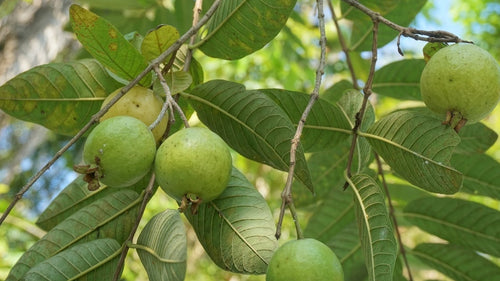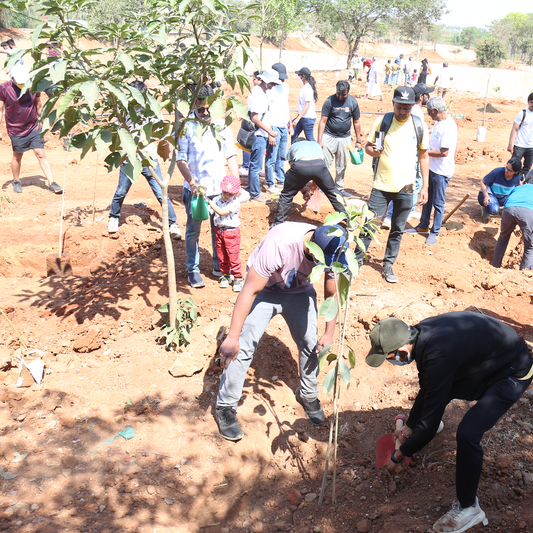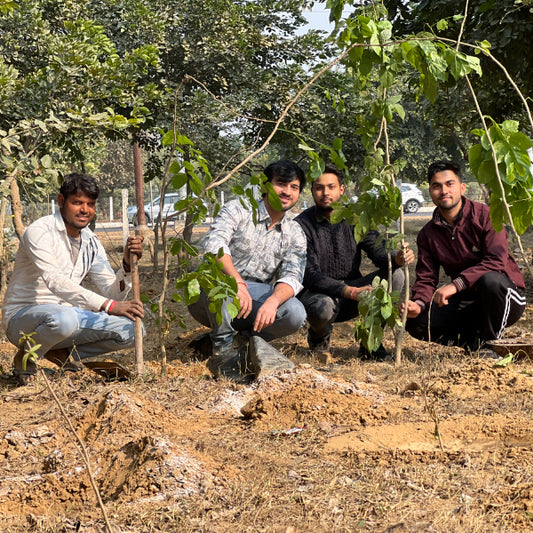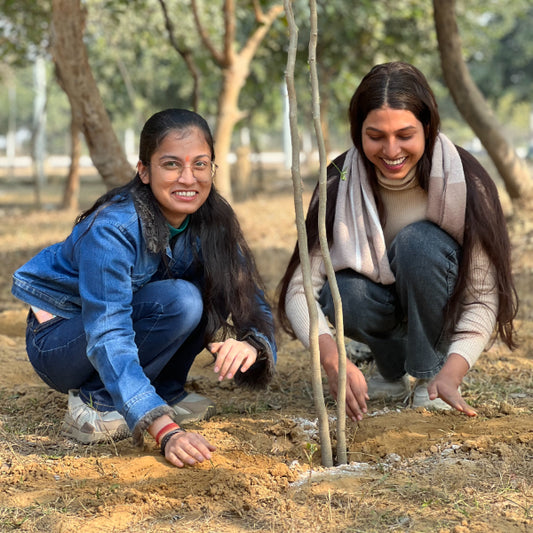Growing a Greener Future: Planting the Seeds of Sustainability
Celebrating MAA10 Chennai’s 1st Anniversary with 500 Trees At Digital Connexion, we believe in innovation that goes beyond technology it connects pe Read more
Plantation Site Gallery
Project Update 1
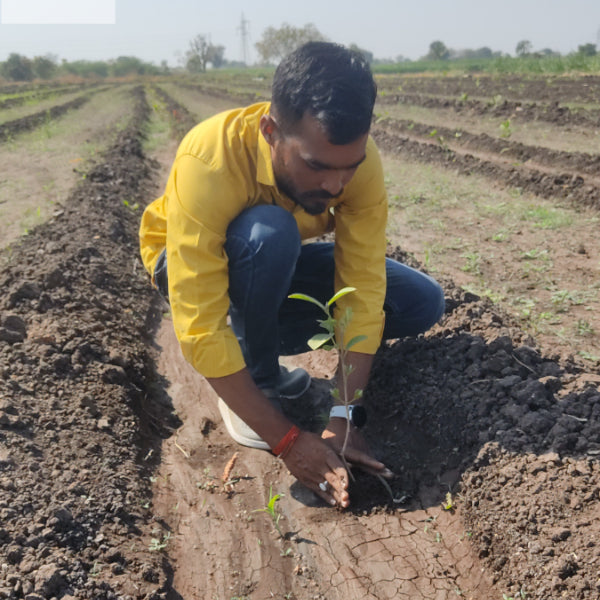
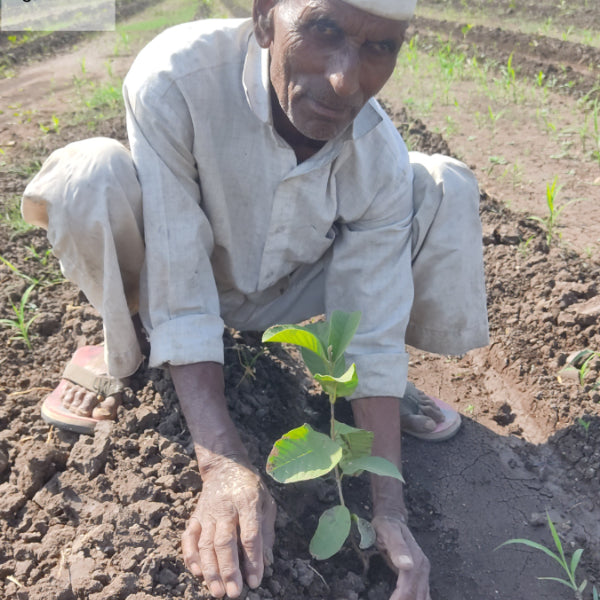


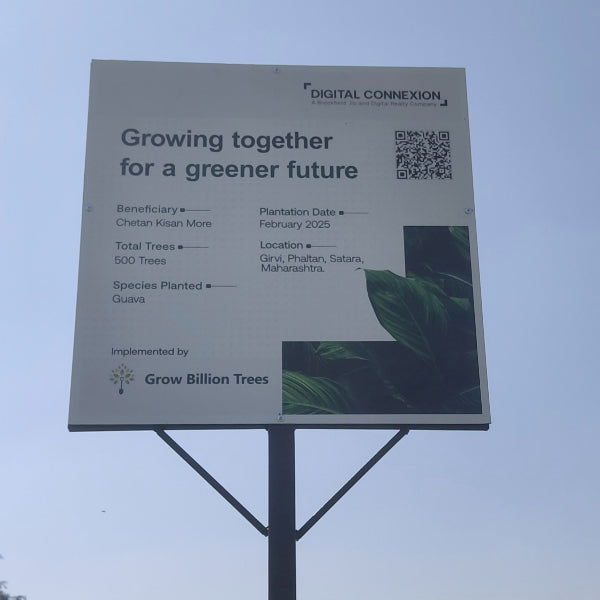
Digital Forest
Forest with 500 Trees planted
Growing a Greener Future: Planting the Seeds of Sustainability
Celebrating MAA10 Chennai’s 1st Anniversary with 500 Trees
At Digital Connexion, we believe in innovation that goes beyond technology it connects people, communities, and the planet. To commemorate the 1st anniversary of our MAA10 Chennai facility, we’ve planted 500 trees as part of a meaningful initiative that reflects our commitment to sustainability and environmental stewardship.
Leveraging the agroforest concept, which integrates trees with agricultural crops and livestock, this initiative improves soil fertility. These agroforests act as carbon sinks, reduce greenhouse gas emissions, and support biodiversity by creating vital habitats.
By blending innovation with grassroots sustainability efforts, we aim to foster ecological balance while empowering farming communities through sustainable practices. This initiative underscores our dedication to a greener, more connected future, where technology and environmental responsibility work hand in hand.
Tree Plantation Date
5th February 2025
Tree Plantation Location
Girvi, Phaltan, Satara Maharashtra - 415523
Trees Planted
Total Count: 500 Trees
Species Name: Guava
Forest Type: Agroforest
Digital Connexion, a joint venture between Brookfield Asset Management, Reliance Industries Limited, and Digital Realty, has taken a significant step toward environmental sustainability with its tree plantation initiative in the agroforest concept. Agroforestry, the integration of trees into agricultural landscapes, is a sustainable land-use practice that benefits both the environment and local communities. By planting trees in agroforests, Digital Connexion is contributing to ecological balance, improving soil health, and fostering biodiversity. For farmers, agroforestry provides multiple advantages, including improved crop yields, diversified income sources from timber and fruits, and increased resilience against climate change. Through this tree plantation drive, Digital Connexion reaffirms its commitment to reducing its carbon footprint and promoting a greener, more sustainable future, benefiting not just customers but also farmers and the planet at large.
The Advantages Of Agroforestry: A Greener Path Forward
Agroforestry is a sustainable practice that integrates trees with agriculture. By adopting this approach, we are driving long-term sustainability.
Boosted Agricultural Productivity
Strategically placed trees improve temperature and moisture conditions, acting as windbreaks and providing shade. These benefits result in healthier crops, better yields, and increased productivity.
Climate Resilience
Agroforests serve as natural carbon sinks, absorbing CO₂ while protecting crops from climate extremes like droughts and floods. This creates a more stable and sustainable farming environment.
Biodiversity and Ecosystem Health
By creating habitats for birds, bees, and other pollinators, agroforests enhance biodiversity, leading to improved crop yields through natural pollination and pest control.
Improved Soil and Water Management
Tree roots reduce soil erosion, enhance water retention, and aid groundwater recharge. By preserving topsoil and conserving water, agroforestry ensures healthier and more sustainable agriculture.
Activities During Tree Plantation
During Digital Connexion’s tree plantation initiative, all plantation-related activities are carried out by experienced farmers as part of the agroforest concept. The process begins with site preparation, including soil testing, plowing, and enriching the soil with organic compost to ensure optimal growing conditions. Farmers carefully plant a mix of selected native and economically beneficial tree species that support biodiversity and align with agroforestry principles. The saplings are planted in patterns that integrate seamlessly with existing agricultural crops, promoting ecological balance and productivity. Post-plantation, farmers are responsible for watering, mulching, and maintaining the saplings to ensure healthy growth. This hands-on approach not only ensures professional care for the trees but also empowers farmers by creating sustainable livelihood opportunities while fostering a greener environment.
Planting With Purpose
Through this initiative, we are restoring land and reinforcing our commitment to a greener, more resilient future. Every step reflects our commitment to sustainability. Experienced farmers prepare the land with soil testing and composting to ensure optimal conditions. Native and economically beneficial tree species are carefully planted alongside crops to align with agroforestry principles, promoting ecological balance and agricultural productivity.
Post-plantation, farmers nurture the saplings through watering, mulching, and maintenance, ensuring their healthy growth. This hands-on approach fosters a greener environment and also creates meaningful livelihood opportunities, empowering farming communities while building a sustainable future.
Advancing Global Goals Through Our Agroforest Initiative
Our agroforest tree plantation initiative aligns with key Sustainable Development Goals (SDGs), reflecting our commitment to sustainability and community empowerment. Here's how our efforts contribute to a better future:
Good Health and Well-Being
By enhancing air quality, reducing soil erosion, and improving water resources, our initiative promotes healthier living conditions for communities. Agroforests also contribute to nutritious food availability, fostering better overall well-being.
Industry, Innovation, and Infrastructure
By promoting climate-smart agroforestry and leveraging innovative technologies in agriculture, our initiative drives sustainable development and encourages the adoption of green infrastructure solutions for long-term resilience.
Responsible Consumption and Production
Agroforestry minimizes reliance on chemical fertilizers and pesticides while promoting sustainable land use practices. This approach ensures agricultural production aligns with environmental conservation and responsible resource consumption.
Climate Action
Agroforests act as carbon sinks, absorbing carbon dioxide and reducing farming’s carbon footprint. They also enhance resilience to climate extremes, such as droughts and floods, mitigating the effects of climate change.
Life Below Water
By reducing soil erosion and runoff, agroforestry safeguards water quality in nearby rivers and streams and protects aquatic life.
Life on Land
Our initiative promotes biodiversity by creating habitats for wildlife and restoring the degraded environment. Native tree planting combats deforestation and supports the long-term health of both forests and land
ESGs Achieved Through Agroforestry
Environmental (E): Building a Greener Planet
Through our agroforest initiative, we actively contribute to environmental sustainability. By planting native trees alongside crops, we enhance soil health, prevent erosion, and improve water retention, supporting the long-term vitality of ecosystems. Acting as carbon sinks, these trees absorb CO2, mitigating climate change and restoring degraded lands. This initiative fosters ecosystem regeneration and promotes resilient agricultural practices.
Social (S): Empowering Communities
Our efforts uplift local communities by providing farmers with diversified income sources, such as timber, fruits, and forest products, reducing poverty and enhancing financial stability. By involving farmers in tree plantation and agroforestry, we equip them with skills for sustainable land use.
Governance (G): Driving Accountability and Impact
The initiative strengthens our governance by embedding transparency, ethics, and accountability into our agroforestry initiatives. It ensures adherence to high governance standards, responsible land management, and compliance with environmental regulations. With a scalable, well-structured model, we uphold decision-making transparency and reinforce our commitment to corporate responsibility and environmental stewardship.
Through our agroforest initiative, we’re not just planting trees we’re building stronger communities, healthier ecosystems, and a more sustainable future for generations to come.
Commitment by Grow Billion Trees
Grow Billion Trees is committed to driving sustainable plantation efforts, ensuring every initiative aligns with key environmental objectives and promotes long-term ecological balance. We focus on selecting native tree species that are well-adapted to local ecosystems, ensuring a higher survival rate and stronger environmental impact.
To maintain plant health and longevity, Grow Billion Trees emphasizes continuous maintenance and regular monitoring of the plantations. This approach helps ensure that each tree thrives, contributing effectively to both biodiversity and climate resilience.
Transparency is a core principle in our operations. Clients receive comprehensive reports, including geo-tagging of planted trees, survival rate updates, and ongoing progress reports. This level of openness allows clients to track the direct impact of their contributions, reinforcing trust and accountability.
Through our dedication to sustainable practices, Grow Billion Trees ensures that every plantation project leaves a lasting positive footprint on both the environment and the local communities it serves.
Summary
Digital Connexion’s tree plantation initiative in the agroforest concept is a powerful step towards environmental sustainability and supporting local farmers. To commemorate the 1st anniversary of its MAA10 Chennai facility, the company planted trees as part of its commitment to a greener future. The initiative integrates tree planting with agricultural practices, enhancing soil health, preventing erosion, and improving water retention. By collaborating with local farmers, Digital Connexion promotes agroforestry, providing income diversification through the sale of timber, fruits, and other forest products. Partnering with Grow Billion Trees, the initiative aligns with global sustainability goals, showcasing the company’s dedication to environmental stewardship and responsible corporate practices.
Trees for Corporates
Trending
Most Popular
FAQ
What is the significance of Digital Connexion’s tree plantation initiative in agroforestry?
Digital Connexion’s tree plantation initiative in the agroforestry concept helps promote sustainability by planting trees alongside agricultural crops. This initiative supports the environment by improving soil health, reducing erosion, and contributing to carbon sequestration. It also provides farmers with income diversification through the sale of timber and other forest products, benefiting both the environment and local communities. This effort underscores our commitment to environmental stewardship and corporate social responsibility.
What role does agroforestry play in promoting sustainability?
Agroforestry is a vital practice that integrates trees with crops or livestock. This approach benefits the environment by increasing biodiversity, enhancing soil fertility, and improving water retention. It also helps reduce carbon footprints through carbon sequestration. For farmers, agroforestry provides a sustainable income model, offering multiple revenue streams from both crops and timber. Digital Connexion’s support for agroforestry exemplifies how businesses can contribute to environmental sustainability while fostering economic growth in rural areas.
How does Digital Connexion’s partnership with Grow Billion Trees support tree plantation efforts?
Digital Connexion’s partnership with Grow Billion Trees strengthens our tree plantation initiative by ensuring that trees are planted using sustainable practices. This collaboration enhances transparency and accountability, contributing to the global goal of achieving environmental sustainability. Grow Billion Trees brings expertise in large-scale tree planting and environmental impact assessment, ensuring our initiatives deliver measurable, long-term benefits to the ecosystem and local communities.
Why is tree planting important for reducing carbon footprints?
Tree planting is a crucial method for reducing carbon footprints because trees absorb carbon dioxide from the atmosphere and store it in their biomass. This natural process helps mitigate the effects of climate change by lowering the overall concentration of greenhouse gases. Digital Connexion’s tree plantation initiative in agroforestry contributes to this goal by planting trees that help offset the company’s carbon emissions, supporting global efforts to combat climate change and promote a sustainable future.
How do farmers benefit from participating in agroforestry tree planting?
Farmers benefit from agroforestry tree planting in several ways. The integration of trees alongside crops improves soil quality, increases water retention, and provides protection against soil erosion. Farmers also gain additional income streams from the sale of timber, fruits, and other forest products. By diversifying their income sources, farmers can reduce financial risks and achieve greater economic stability. Digital Connexion’s involvement in agroforestry empowers farmers by supporting these sustainable practices and providing long-term economic benefits.
How does Digital Connexion ensure sustainability in its tree plantation initiative?
Digital Connexion ensures sustainability in its tree plantation initiative by carefully selecting native tree species that are well-suited to the local ecosystem. The trees are planted as part of an agroforestry system, which maintains agricultural productivity while enhancing environmental health. Through collaboration with local farmers and Grow Billion Trees, we guarantee that the initiative adheres to best practices for long-term environmental and economic sustainability. We also track the progress of the trees to ensure their continued growth and contribution to the ecosystem.
What is the impact of agroforestry on soil health?
Agroforestry has a positive impact on soil health by enhancing its fertility and structure. The deep roots of trees prevent soil erosion and improve water retention, which is especially crucial in regions with irregular rainfall. Trees also enrich the soil by fixing nitrogen, adding organic matter, and increasing microbial activity. This results in healthier, more productive land for farmers, and supports the sustainability of agricultural practices. Digital Connexion’s support for agroforestry directly contributes to improving soil health, making it a win-win for both the environment and farmers.
How does tree plantation in agroforestry contribute to biodiversity?
Tree plantation in agroforestry significantly contributes to biodiversity by creating a habitat for various species of plants, animals, and microorganisms. Trees act as a natural barrier for wildlife, providing shelter and food, while also promoting plant diversity. By integrating trees into agricultural systems, Digital Connexion helps maintain the balance of local ecosystems. This fosters resilience against climate change and enhances ecosystem services, benefiting farmers and communities by sustaining healthy, diverse environments.
What is the relationship between tree planting and water conservation?
Tree planting plays a crucial role in water conservation by improving water retention in the soil and reducing runoff. The roots of trees absorb and store water, allowing it to slowly percolate into the ground, replenishing groundwater supplies. Trees also act as natural filters, preventing pollutants from entering water sources. Digital Connexion’s agroforestry tree planting initiative contributes to water conservation by supporting the establishment of sustainable water cycles, benefiting farmers with better irrigation and healthier land.
How does Digital Connexion’s tree planting initiative align with India’s environmental goals?
Digital Connexion’s tree planting initiative aligns with India’s environmental goals by supporting sustainable practices that contribute to the country’s climate action plans. The initiative helps reduce carbon emissions, improves soil health, promotes biodiversity, and conserves water resources. By working with local farmers and supporting agroforestry, we contribute to India’s goals of achieving a more sustainable and climate-resilient future. This initiative is a step toward realizing the country's environmental targets, such as increasing forest cover and reducing the carbon intensity of its economy.
1. Agroforestry and Sustainability
it’s not just there to look pretty—it’s saving the planet!
2. Tree Planting for Carbon Footprint Reduction
Digital Connexion takes a bold step towards cutting its carbon footprint with tree planting. But why stop at one tree when five can do the trick? By planting trees in agroforestry systems, the company isn’t just playing tree-hugger—they’re actively reducing carbon dioxide levels and helping fight climate change. Trees absorb carbon, trap it in their roots, and release oxygen, so they’re like nature’s air purifiers. Every tree planted on behalf of customers acts as a tiny carbon sponge. Digital Connexion is ensuring that their digital infrastructure, while supporting a growing online world, doesn’t leave a giant carbon footprint behind. After all, why shouldn’t the future of data centers be as green as it is high-tech?
3. Digital Connexion’s Green Commitment
Who said data centers can’t be eco-friendly? Digital Connexion’s tree plantation initiative is their way of proving that technology and sustainability can coexist in harmony. In fact, it’s all part of their larger green commitment to reducing the environmental impact of their operations. Through tree planting in agroforestry systems, they are offsetting carbon emissions and making the planet greener, one tree at a time. So, as the digital world continues to expand, Digital Connexion is planting roots (literally and figuratively) to ensure that their tech doesn’t come at the planet's expense. With the environment in mind, their green initiatives pave the way for a more sustainable future for both technology and nature.
4. Agroforestry Benefits for Farmers
Farmers, rejoice! Agroforestry isn’t just about planting trees—it’s about reaping serious rewards. By integrating trees into their farming systems, farmers enjoy benefits like improved soil fertility, water conservation, and protection from harsh weather. The best part? Trees provide additional income streams through timber, fruits, and other forest products. For farmers, this means diversifying their income and reducing risks that come from relying solely on crops. Digital Connexion’s agroforestry initiative is helping farmers see the benefits firsthand, proving that trees aren’t just for shade—they’re financial assets. Plus, with a side of carbon offsetting, who wouldn’t want to plant a tree?
5. Corporate Social Responsibility in Agroforestry
Corporate social responsibility (CSR) takes on a whole new meaning with agroforestry. Digital Connexion has taken the concept of CSR to the next level by planting trees as part of their commitment to sustainability. The company’s collaboration with local farmers and Grow Billion Trees demonstrates how businesses can directly contribute to environmental conservation. CSR is not just about donating funds—it’s about taking action. Digital Connexion’s tree planting initiative shows that when companies invest in the environment, they help create a healthier ecosystem, boost local economies, and promote sustainability at scale. After all, doing good for the planet is good for business!
6. Biodiversity and Agroforestry
Agroforestry is the MVP of biodiversity! Trees create a habitat for wildlife, prevent soil erosion, and support a healthy ecosystem. When companies like Digital Connexion integrate agroforestry into their sustainability practices, they help preserve biodiversity while offering farmers a more stable income. By planting trees in agroforestry systems, Digital Connexion isn’t just planting a future for themselves—they’re planting a future for wildlife and the surrounding ecosystems. The mix of trees and crops creates a thriving environment where all species can flourish. In short, agroforestry isn’t just about crops and timber; it’s about saving the planet’s flora and fauna, one tree at a time.
7. Digital Infrastructure and Environmental Impact
The world may be going digital, but that doesn’t mean we should forget about the planet. Digital Connexion is proving that even the most high-tech industries can be environmentally conscious. Their tree planting initiative in agroforestry systems helps counterbalance the environmental impact of expanding digital infrastructure. By combining cutting-edge tech with nature, they’re ensuring that the growth of the digital world doesn’t come at the expense of the environment. As the demand for digital services increases, so too does the need for businesses to adopt sustainable practices, and Digital Connexion is leading the way with its green initiatives.
8. Corporate Green Initiatives and the Future of Agriculture
The future of agriculture is green—and it’s not just about producing more food. Digital Connexion’s tree plantation initiative is helping shape a new, more sustainable agricultural future by blending technology with nature. Agroforestry plays a key role in this transformation by promoting crop diversification, improving soil health, and reducing the environmental impact of farming. With the support of businesses like Digital Connexion, the future of agriculture can be both high-tech and eco-friendly. This corporate green initiative is proof that sustainability and profitability can go hand in hand, paving the way for a future where technology and agriculture work together for a greener tomorrow.
- Choosing a selection results in a full page refresh.
- Opens in a new window.


